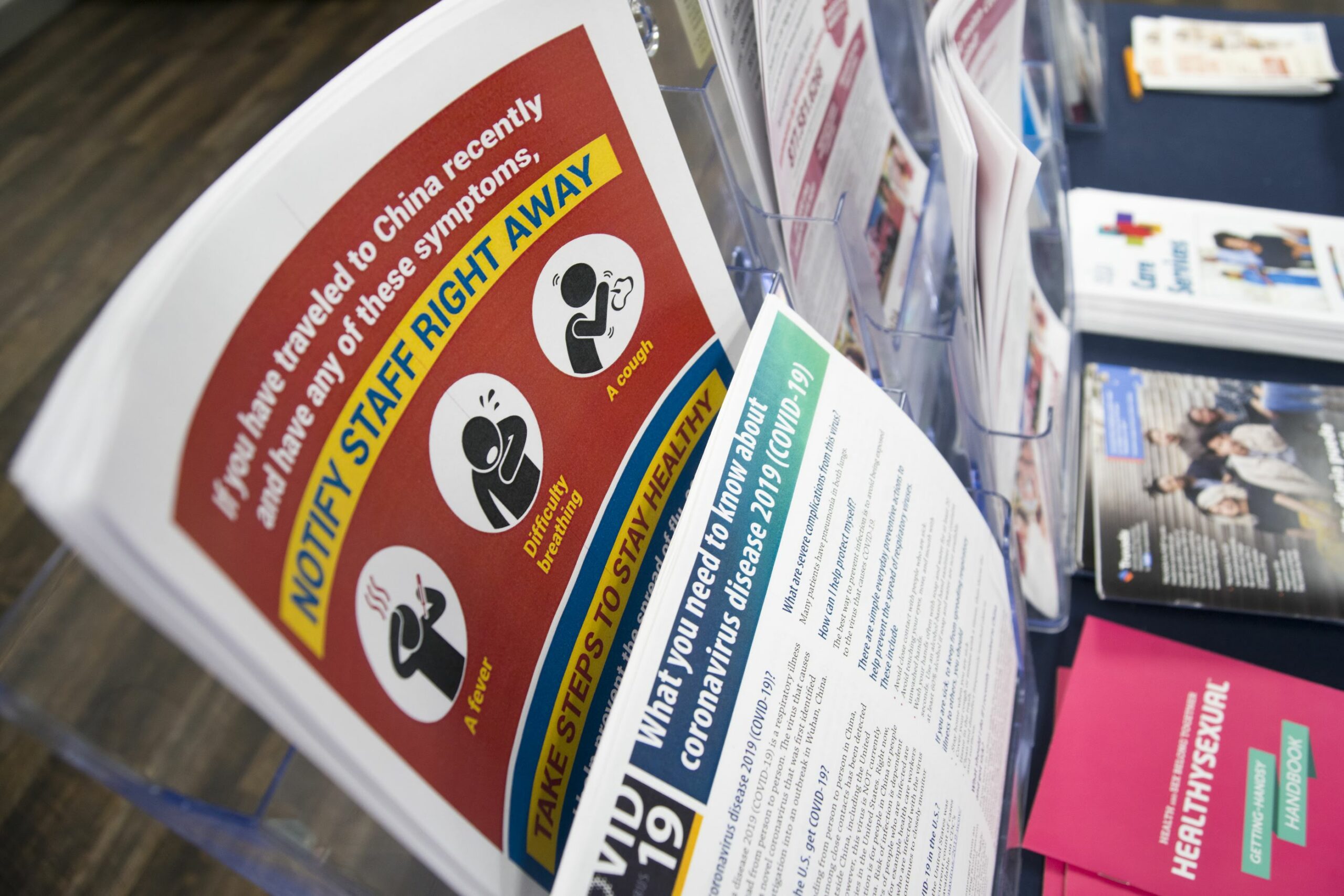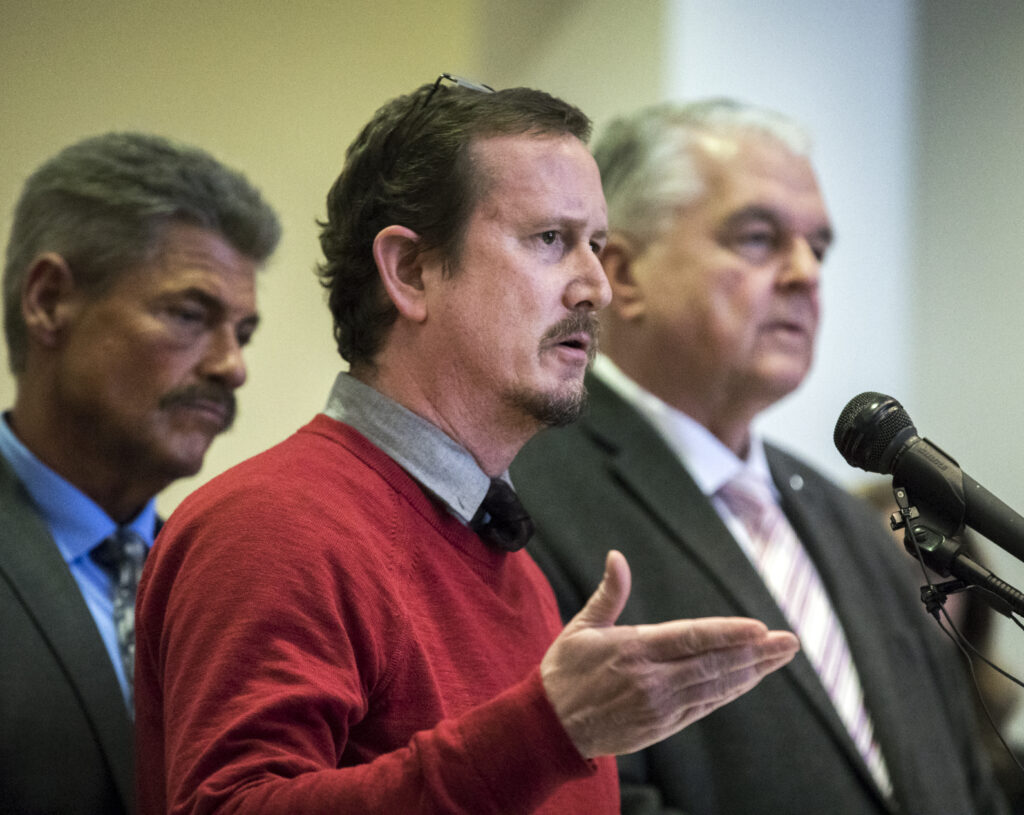Indy Q&A: State Public Health Laboratory Director Dr. Mark Pandori on how testing for the coronavirus in Nevada is evolving

As the number of confirmed cases of the novel coronavirus have continued to rise across the state, the actual scope of viral infections is unknown as the expansion of testing infrastructure continues to lag behind the number of likely cases.
A portion of the testing burden has been performed by the state’s public health laboratory at the University of Nevada, Reno, where doctors have tested more than 600 samples since the emergence of COVID-19 in the U.S. earlier this month.
Nearly two weeks ago, just as the state began to confirm its first cases, The Nevada Independent sat down with the lab’s director, Dr. Mark Pandori, to discuss what the testing process looked like. Today, the Independent again spoke with Pandori to find out the newest developments including how the state has adapted its testing process, and how the disease’s rapid spread could put pressure on the state’s limited testing infrastructure.
This interview was edited for length and clarity.

The Nevada Independent: Is this where you expected to see this 12 days ago, or has it changed more than you thought?
Well, the only change [is] that certain materials that are needed to test are becoming or growing into a situation where they're in very short supply. We didn't anticipate some of the shortages that we're seeing now in terms of some of the ancillary reagents that are required to run the lab test. So while the availability of test kits, so to speak, from CDC is high, some of the materials that are needed to use those kits is running rather low, and that was not expected 12 days ago. But certainly now that testing is ramped up and the criteria are wide and there's a lot of demand for testing, there is a shortage of many supplies associated with testing, not even necessarily test kits as you hear quite often.
Did you expect to see this much change? They're closing casinos, people are getting laid off.
You're asking if I saw that in my crystal ball? I didn't see anything in my crystal ball 12 days ago except more fog… I certainly did not think we were going to be in a better situation 12 days later. I knew that these things tend to get worse before they get better, but when you look at some of the things you just alluded to, like closing casinos or closing restaurants or creating shelter-in-place orders, those kinds of things, as you're hearing from around the United States, the thing that's most important to recognize about that is, as scary as it seems — or maybe you're upset because you can't do certain things that you wanted to do — it's really, you have to say, what do we have to fight this? And at the same time, the converse, is what don't we have?
Let's look at that. We don't have a vaccine, and we don't have drugs, and we don't even have spectacular surveillance data, which is to say, we know how much is really out there yet. So when you recognize that we don't have those things, we have to concentrate really firmly on what we do have. That is, we have testing, and that can help us determine what's going on to some degree and who needs what. We also then have these sorts of social tactics that we utilize, like closing things, shutting down group events. It's all we got. The thing about it is...we have that and we have things like coughing into your elbow and making sure that if you're unwell you don't go to work, but now that's [all] just being enforced in a different way.
But again, think about this. So when you consider what we don't have, and we look at what we do have, now it's the job of the public to do the public health. The job of the public doing the public health means follow, comply with what you're hearing. It matters. Infectious diseases are spread by people being close and touching other people or getting bodily fluids from other people. It's a very, very reasonable expectation that if we do that less, we're going to limit the spread of the virus. Right now, the thing is that the public has the opportunity to do public health.
The Southern Nevada Public Health Laboratory said that it was out of extraction kits and was requesting help from the state lab. Have you been able to provide them with that?
We received specimens this morning from Southern Nevada Public Health Lab, and they're currently in the process of being tested, and we anticipate more will come as a result of that outage. Extraction reagents are in limited supply and everybody is working with CDC and FDA to see what our alternatives are.
How many test kits and extraction kits do you have? And how many does the state have?
Right now it's difficult to answer. We're the state public health lab for Nevada, and we're at a capacity to continue to test for several more days, into next week. But I'm hesitant to put a number on it or a day because right now what's changing is the availability of new brands of chemicals and reagents that we can use. So if I say at this moment, we can test into next week, that sounds great, but in fact the landscape is changing so quickly, it looks like we'll be able to attack and adapt and use other things. Our capacity to test is pretty high right now, but how long it will last depends on how and what other vendors we can use to buy things.
When do you expect to see more tests come in from the CDC or from private vendors?
This is very complicated, and I think one of the biggest issues with talking about the number of test kits is that test kits are complicated. This is a little bit like if you said to me, “I need to make brownies.” All right, what is it that you need? You need a brownie mix, and the CDC can send that brownie mix out, no problem, and they've done a very good job of that. But let's say that to make that brownie mix, you need eggs and you need butter. Well, if they stop making eggs, how are you going to make the brownies? See? So CDC has been really good at providing brownie mix, but you need a lot of other things to make brownies for the analogy. So it really depends on if we get more eggs and butter.
So when the CDC sends you a test kit, you're not getting everything you need to test something, you're getting kind of the base to test someone?
You're getting what we call the analyte-specific reagent, and those are the reagents that are specific to the COVID-19 disease entity, SARS-CoV-2. That's what they're providing.
Where are you getting the so-called “eggs and butter?”
There's myriad companies that provide those things, and they're private entities... What's happening is the FDA is approving these vendors one by one, and it's not going very quickly. So now there should be some changes coming in the next few days, where these decisions that get made might change dramatically… but, as the vendors expand, opportunities to provide testing will expand, and so this is still chugging along quite well.
Do you have any models or numbers that can tell you how many cases the state may see?
That's well outside my profession and my career to project. One thing I will say to you is as you do more testing in a situation like this, you will find more cases. The shape of that upward curve... I don't know the shape of it, or at what rate, or if this will grow exponentially or anything further. I would not be in a position to say. But as you test more, expect to find more cases.
How many people have you tested so far?
Well, we have a lot of testing going on today. We've tested 625 human beings, and I mean patients so far here at the public health lab.
Is there a backlog of tests?
No. Everything that came in yesterday has been tested so far. We have many, many specimens today and the expectation is that we'll get through at least half of them, but there will be testing that will go into tomorrow. We'll be working into the night to get those tested. But the volume has been so high that we can no longer guarantee turning a result around the same day we get a specimen. However, tomorrow we expect to get those out. But again, tomorrow we're probably going to get a lot more to test.
So if you have the same amount coming in, you'll expect to see a backlog at some point?
I don't know because we're changing our personnel here in the lab to move to more shifts. And so there is a possibility that the rate of testing will change.
Who is being tested? Is it just people who have symptoms or have a history of exposure or being in an affected place?
I think you pretty much nailed it. But it's an opportunity to remind [you] that testing resources and medical resources are limited and this is not a time to go and get a COVID-19 test just because you feel like it or to go get a COVID-19 test because you're kind of curious whether you might have COVID-19. If you're well and your family as well, then you should be complying with whatever the government is currently asking you to do. They're not trying to scare you or to make life inconvenient. We're trying to use the only tool that we have to fight this from a public health perspective, and that means just staying home.
If you're well, you don't need a COVID-19 test, because these resources should be reserved for people, as you just articulated, that are symptomatic, maybe in dire symptomatic shape, but also who have been ascertained by public health to be contacts to known cases, in which case we can try to snap transmission networks. But it's an opportunity to just say right now… who's being tested are people that we decide — not we, the lab, but the public health community decide — really need that test.
You said you've tested 600-something people. We have about 50 or 60 confirmed cases right now in the state. When you get a confirmed case, what do you do?
These are diagnostic laboratory tests and the laws are unambiguous and very, very clear about how a diagnostic lab test is reported. Whoever ordered that test, and in Nevada that would be a clinician, they get that test result for their patient. And then if it's a positive test result, public health will get that information… And it's really important that clinicians serve as intermediaries to these tests because the test results are sometimes complicated and they need to be interpreted by a doctor.
How many lab techs do you have running tests right now?
Right now we've recruited people from other parts of the lab, and we probably have around six or seven people right now dedicated to this.
Are there plans to bring in more staff?
Well, you're limited in a field like this by, sometimes, the equipment that you have. So yes, we do want to perhaps bring in more professional lab scientists, but right now we're doing pretty well with what we've got. But it might come to that. Again, I can't say for certain because we have been so far shuffling around our staff and trying to decide how many shifts we can get going running this test. So I can't say exactly that we're going to bring in more people, but we'll see.
Can you look into bringing in more equipment?
Yeah, we are. The biggest thing is dollars and, you know, as long as the dollars arrive to support this, there is equipment that could be brought in that would support our effort to test. And we are looking into some equipment that the FDA's recently deemed as effective for this. And if we can get some more equipment in here, our bandwidth or through-put for testing should expand quite a lot.
What kind of hours are you guys working?
Well, right now we're going pretty full tilt. We've got people coming in, five in the morning, and we have people staying until well into the night — and if the volume of testing continues to come in, we may have to push that into the early morning hours. But right now, it's well into the night and coming in at around five in the morning. But, like I said, we might just have to go to a 24/7. We've been working every weekend doing this, but whatever it takes. We're going to do whatever it takes to try to maintain the test volumes.
Are you all doing okay mentally? How are spirits?
Well, thank you for asking. Any endeavor that requires effort outside normal work hours can create a little confusion and dismay. But I have to commend our staff to a person that they recognize the importance of what they're doing, and they're taking this effort and really doing very well in terms of attitude and in terms of physical health and mental health. How sustainable is something like this? You can never tell. But as of right now our staff are doing very well.
Are you guys doing any extra things to keep safe, or is it the same safety precautions you would normally use?
That's a really good question, because it doesn't come up very often. But this organism comes into our lab in the form of a human specimen and we treat that at what's called a biosafety level, a two level, and there are four biosafety levels. Four would be what you see in the Hollywood movies and space suits, kind of. We have a BSL-three (biosafety level three) facility here that we generally use for agents of bio-terror or tuberculosis culture. This is biosafety level two. So it's not very different than many of the other organisms that we deal with and we have. We work using nothing really categorically different than any other biosafety level two organism that we would deal with.
What should people do if they think they have symptoms?
Well I think, you should ask a doctor. The severity of the symptoms really matters here, because keep in mind the symptoms that we're talking about are caused by a really wide range of very common organisms. So it really benefits the entire community and the entire response for people to ascertain, very carefully, how well or how badly do you feel.
Because if it's just the sniffles, the probability is extremely high that you have something like a rhinovirus or you know what we call a cold virus, let's say. If you're really, really unwell, you have to go [the] emergency room or go see your doctor, of course. And that's probably the moment when a test might occur, but it really is more for a clinician to answer. But I would say gauge your symptoms carefully and make sure that we're not overreacting.
Do you expect this to get better anytime soon?
That's a very difficult question, and it's not one that I seek to necessarily provide an answer to. My job is to test people… I will say this: the actions that are being taken by public health and by laboratories and by clinicians — and also by the public — are all the right things to do to make this get better. We're in uncharted waters here in terms of asking people to social distance and not go out into closed businesses.
And I know I went on at length about this before, but it's an integral part because I can't look into a crystal ball and say whether it's going to get better or worse, but there is every, honestly, every single reason to believe that if we do these things, and if we hold tight to these recommendations about social distancing, and we manage our resources properly by not necessarily going and using medical resources when we shouldn't be, then there's every reason to believe this is going to get better.
